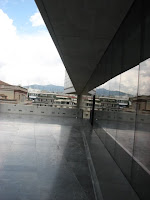Turkey, to my surprise, was a lush, well cultured, rich and beautiful country that I would have never imagined I would be so taken by everything they had to offer. I was so fascinated and felt a very deep connection to the areas we visited, I made a mental note that this is a place I would want to visit and spend at least 2 weeks exploring the place.
We first visited the ancient Ephesus area. Most notably known for the Library of Celcus, the entire ancient city, in ruins today, spreads over a very large area. I would say, this city must have been one of the leading modern cities of its time; it had an amphitheater, hospital, advanced and complex waste water & portable water system, it had public bath houses, public toilet systems, it had a LIBRARY !!!, market place and of course housing.
We first visited the ancient Ephesus area. Most notably known for the Library of Celcus, the entire ancient city, in ruins today, spreads over a very large area. I would say, this city must have been one of the leading modern cities of its time; it had an amphitheater, hospital, advanced and complex waste water & portable water system, it had public bath houses, public toilet systems, it had a LIBRARY !!!, market place and of course housing.





 Ephesus, Turkey - Images (c) Manori Sumanasinghe 2010
Ephesus, Turkey - Images (c) Manori Sumanasinghe 2010If visiting the ruins weren't enough, we had the opportunity to enjoy the local culture and hospitality a bit. One of the things I will not forget about Turkey was how nice all locals were. They are extremely friendly and courteous.
Then we made our way to Church of St. John the Apostle. It is quite amazing how after all these years since his time, a church with the final resting place of St. John the apostle is still intact.
Then we made our way to Church of St. John the Apostle. It is quite amazing how after all these years since his time, a church with the final resting place of St. John the apostle is still intact.


We had an opportunity to visit a Carpet Weaving school of Turkey Ministry of Education. It was a beautiful experience. If you want to buy a Genuine Turkish Carpet, we heard this is one of the cheapest places you can find one.


I have always admired the beautiful hand-woven rugs but never had the desire to make one mine. After visiting this place, I now can't wait till the day I can own a hand woven Turkish rug.
We then went to visit house of Mary, the place where Mary - mother of Jesus, spent her last days. A small charming chapel does not have a burial chamber for this is not her last resting place but they still have sermons for the tourists and the Christian Minority to take part in. I have never sat through an entire mass service and a sermon before and I had the privilege to do so here. Though I am not a Christian or Catholic, I appreciated the experiences.





















































